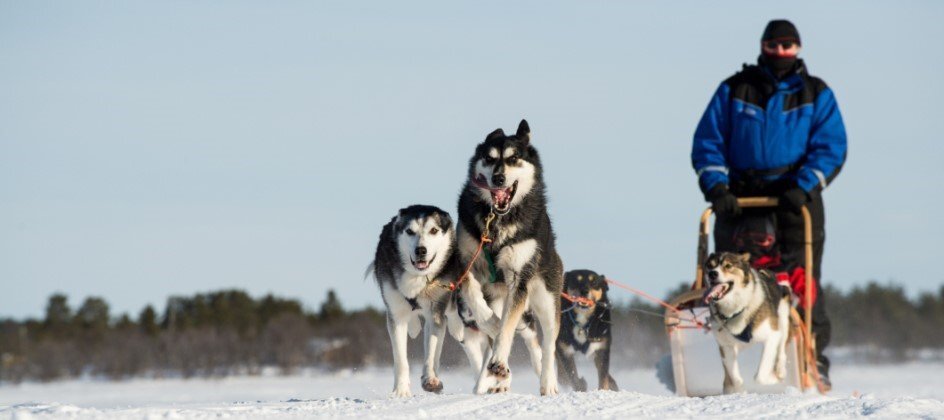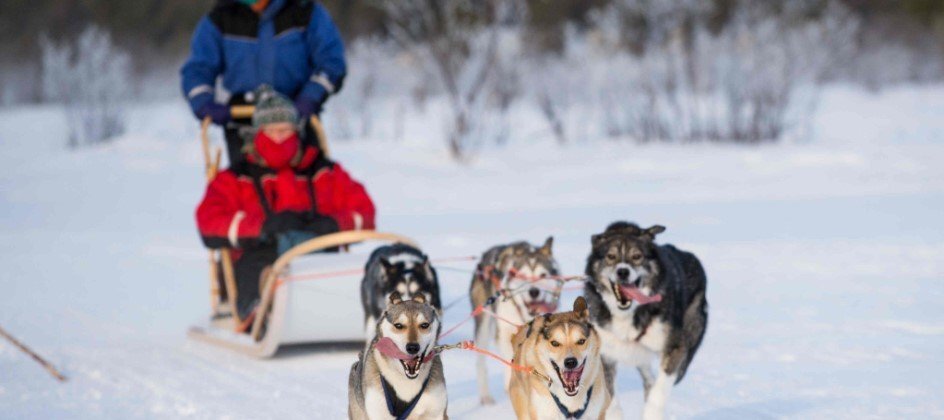The Northern Lights are absolutely spectacular. The snow-covered landscapes are awe-inspiringly lovely. The setting is magical. The reindeer are remarkable. But for some travelers the huskies themselves are the icing on the cake, the best thing about a holiday to the beautiful, glittering, ice-covered far north.
Here's everything you need to know about husky dogs and husky rides, about the most extraordinary dog breed you'll meet in Lapland, the living powerhouses behind the famously popular husky dog sledding experiences our customers enjoy so much.
_w=1240_h=500_pjpg.jpg?v=202509161525)
Introducing the husky dog
The word 'husky' has its roots in an Eskimo word that describes 'the ones that eat raw meat'. The same word gave us both husky and Eskimo names. In today's world we have two husky breeds: Siberian husky, established in the USA in the early 1930s, and Alaskan husky, present ever since being bred by Athabascan Indians settled along the almighty Yukon river. Both breeds are among the oldest human companions in the world, since some recent explorations in eastern Siberia have evidence of the husky sled dogs living with Chukchi ancestors 7,500 years ago.
The original gene pool of the Alaskan husky was permanently changed in the late 19th century with discovery of gold in Klondike (North Canada) and later in Alaska. The blossoming need for sled dogs, brought many other dog breeds to the original soil of husky dogs and, in case of Alaskan huskies, their genes were changed. Since the breed itself was never registered in any of the kennel clubs as a 'purebred', the owners and breeders of Alaskan huskies were never focused on a uniform look and appearance, but rather in performance, metabolism, appetite, how tough their feet were, athleticism, proper Arctic coat resistancy, leadership and intelligence, bravery, ability to bond with their drivers, the intake of food with connection to their speed, stamina and endurance.
In the modern Alaskan husky era, the use of dogs was dramatically reduced in the late 1960s with the massive introduction of snowmobiles. Some parts of Alaska lost most of their huskies. Mushers who thought the breed was in danger, established races and created what is nowadays known as 'The Last Great Race on Earth', the Iditarod almost 2,000 km long. The renewed use of dogs for racing brought back the focus on the breed which was saved from extinction.
In the late 1980s through early 2000s tourist rides started to be popular and a new job was created for dogs to ensure their survival. Even though in both cases, in North Eastern parts of Siberia where Chukchi people raised grandfathers of Siberian huskies and in Alaska where Athabascan Indians created grandfathers of Alaskan huskies, due to extremely harsh conditions, only the fittest dogs could survive. The created efficiency in metabolic processes of huskies is such that dogs are still part of research projects in order to understand why are they so unique – with their perfected energy use and shortest recovery period of all animals known to the human race. 'Nothing can fly, swim or run as fast and as long as the husky' is the old saying in Alaska...
No wonder the husky is so good at its job!
Above all, the husky is a working dog. Thousands of years of sled pulling, hunting and helping their human owners have created a dog who genuinely loves to run and can easily cover 25 miles over the frozen land without stopping. Famed for their endless passion for running and extraordinary endurance, these semi-domesticated animals are packed with raw energy plus boast remarkable pale blue eyes and fine, intelligent faces.
Husky food, games, toys and treats
Huskies like ordinary dog food but they really like raw meat more, which is why so many husky owners feed their dogs healthy raw food like: chicken, beef, lamb, fish, fruit and vegetables.
In Alaska it is not uncommon to see some owners feed their huskies with beaver, bear, caribou or moose meat, but mostly it is salmon or other fish. In general the huskies' diet is very rich in fat and protein, with some fibre for better digestion.
Obviously, huskies love running in pack and pulling sleds. Because they're extremely pack-oriented, they’re most happy in the company of other dogs. They adore agility training, with all the physical and mental challenges it brings. These dogs love to run... and run, and run, a great way to burn off the enormous amounts of energy they have. Owners who live close to cities or in towns train their dogs by attaching themselves to their dog using a belt, bungee rope and harness to jog or run in nature or city parks, because huskies actively enjoy the feeling of pulling something behind. In Europe people take their huskies 'skijoring' (ie, ski-driving) on snow, using a special shoulder harness for the dog, a special belt, a bungee rope and pair of skis. All the owner needs to do on a very special one-on-one husky action like this is remain upright!
_w=1240_h=500_pjpg.jpg?v=202509161525)
About the husky breed
While the Alaskan husky is a very specific breed – one of a kind in the world – there are other sled dog breeds. The Siberian husky was originally bred in northeast Asia by the Chukchi people, an ancient Siberian hunting tribe whose dogs helped them travel huge distances and hunt to survive more effectively. Medium-sized, fast and light on their feet, these dogs are great athletes. They have a very thick double coat, triangular ears and a really lovely, warm, friendly nature.
An incredibly powerful dog with a great deal of endurance, the super-intelligent Alaskan Malamute was bred to haul heavy loads. While they're a bit slower than other sled dogs they can pull heavy loads thanks to their sheer strength. They were first bred by the Malemiut Inupiaq people in the remote Alaskan Norton Sound region. It looks like the Malamute and Siberian husky share a close genetic relationship, and they both are genetically similar to the Alaskan husky since about 100 years ago.
The Greenland dog is big, strong and heavily built, originally bred to hunt polar bears and seals as well as pull sleds. It has a wide head and small ears, all covered with thick fur. These days mostly kept as working dogs, they have particularly strong, muscular legs covered in short water-repellent fur. A Greenland dog has a cute habit of hiding its nose in its fluffy tail when it sleeps.
Other sled dogs include the Canadian Eskimo dog, Samoyed and Chinook. The modern crosses – Greysters and Euro hounds – are very popular in sprint racing. They are by far the fastest of all sled dogs.
Enjoy spectacular husky rides in Lapland
There's nothing quite like an exhilarating husky safari to get your blood zooming around your body. Feel the unique excitement, watch the stunning landscape as it speeds by and see the dogs' raw pleasure doing what they live and breathe for: running.
Most of our Lapland tours include unforgettable times with these amazing dogs! Find out more here
Originally published 1 April 2019, updated 20 January 2024
